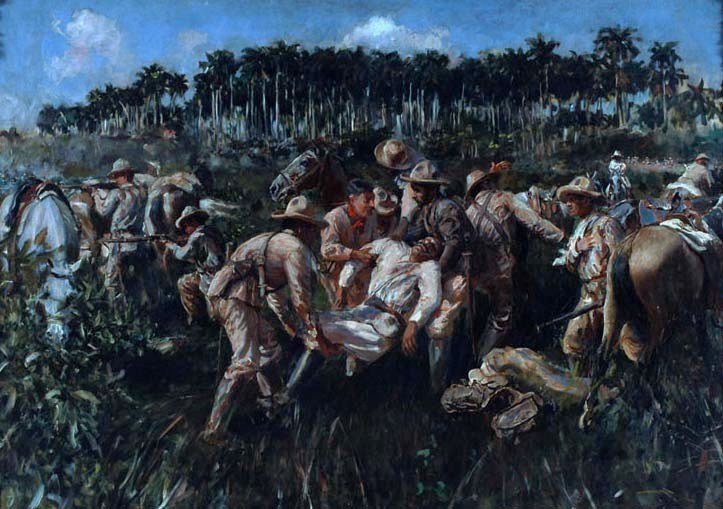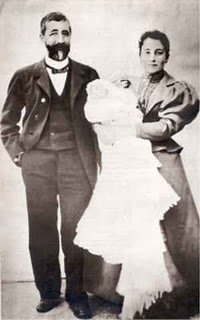|
Cuba–Spain Relations
Cuba–Spain relations are the bilateral relations between the Cuba, Republic of Cuba and the Spain, Kingdom of Spain, which date back to the 15th century. Cuba was a Spanish colony from 1492 up until 1898, when the United States took over the territory in the Spanish–American War. Many Cubans have ancestry from Spain. Many Spaniards escaped the first Spanish Civil War and went to Cuba, and other countries, around 1820–1825. History Spanish colonization The first contact between Spain and the island of Cuba was in October 1492 when explorer Christopher Columbus arrived to Cuba. The first permanent Spanish settlement on the island began in 1511 when Spanish conquistador Diego Velázquez de Cuéllar established a settlement in Baracoa. Cuba would become the launching point for further Spanish exploration on the American continent. By 1521, Cuba became part of the Spanish Empire and was governed from the New Spain, Viceroyalty of New Spain based in Mexico City. During Spanish adm ... [...More Info...] [...Related Items...] OR: [Wikipedia] [Google] [Baidu] |
Bilateral Relations
Bilateralism is the conduct of political, economic, or cultural relations between two sovereign states. It is in contrast to unilateralism or multilateralism, which is activity by a single state or jointly by multiple states, respectively. When states recognize one another as sovereign states and agree to diplomatic relations, they create a bilateral relationship. States with bilateral ties will exchange diplomatic agents such as ambassadors to facilitate dialogues and cooperations. Economic agreements, such as free trade agreements (FTAs) or foreign direct investment (FDI), signed by two states, are a common example of bilateralism. Since most economic agreements are signed according to the specific characteristics of the contracting countries to give preferential treatment to each other, not a generalized principle but a situational differentiation is needed. Thus through bilateralism, states can obtain more tailored agreements and obligations that only apply to particular con ... [...More Info...] [...Related Items...] OR: [Wikipedia] [Google] [Baidu] |
Cuban War Of Independence
The Cuban War of Independence (), also known in Cuba as the Necessary War (), fought from 1895 to 1898, was the last of three liberation wars that Cuba fought against Spain, the other two being the Ten Years' War (1868–1878) and the Little War (1879–1880). During the war, Spain sent 220,285 soldiers to Cuba—according to the Library of Congress, the largest army to cross the Atlantic until World War II. The final three months of the conflict escalated to become the Spanish–American War, with United States forces being deployed in Cuba, Puerto Rico, and the Philippines against Spain. Historians disagree as to the extent that United States officials were motivated to intervene for humanitarian reasons but agree that yellow journalism exaggerated atrocities attributed to Spanish forces against Cuban civilians. Background During the years 1879–1888 of the so-called "Rewarding Truce", lasting for 17 years from the end of the Ten Years' War in 1878, there were fundament ... [...More Info...] [...Related Items...] OR: [Wikipedia] [Google] [Baidu] |
Prime Minister Of Cuba
The prime minister of Cuba (), officially known as the president of the Council of Ministers () between 1976 and 2019, is the head of government of Cuba and the chairman of the Council of Ministers (cabinet). The prime minister is the third-highest office in Cuba, after the first secretary of the Communist Party of Cuba and the president of Cuba, and the second-highest state office. History The office of prime minister was first instituted in 1940 in accordance with the provisions of the Constitution of Cuba as amended in that year. The first prime minister of Cuba was Carlos Saladrigas Zayas (1900–1957), the nephew of former President Alfredo Zayas. The prime minister was also sometimes referred to as "premier" (). Between 1940 and 1959, Cuba saw fifteen changes of prime minister; Félix Lancís Sánchez exercised the role twice (1944–1945 and 1950–1951) while Fulgencio Batista held the position concurrently with that of president of Cuba for one month (April 1952) ... [...More Info...] [...Related Items...] OR: [Wikipedia] [Google] [Baidu] |
Fidel Castro
Fidel Alejandro Castro Ruz (13 August 1926 – 25 November 2016) was a Cuban politician and revolutionary who was the leader of Cuba from 1959 to 2008, serving as the prime minister of Cuba from 1959 to 1976 and President of Cuba, president from 1976 to 2008. Ideologically a Marxist–Leninist and Cuban nationalist, he also served as the First Secretary of the Communist Party of Cuba, first secretary of the Communist Party of Cuba from 1965 until 2011. Under his administration, Cuba became a One-party state, one-party communist state; industry and business were nationalized, and socialist reforms were implemented throughout society. Born in Birán, the son of a wealthy Spanish farmer, Castro adopted leftist and anti-imperialist ideas while studying law at the University of Havana. After participating in rebellions against right-wing governments in the Dominican Republic#Trujillo Era (1930–61), Dominican Republic and La Violencia, Colombia, he planned the overthrow of Cuban ... [...More Info...] [...Related Items...] OR: [Wikipedia] [Google] [Baidu] |
Francisco Franco
Francisco Franco Bahamonde (born Francisco Paulino Hermenegildo Teódulo Franco Bahamonde; 4 December 1892 – 20 November 1975) was a Spanish general and dictator who led the Nationalist faction (Spanish Civil War), Nationalist forces in overthrowing the Second Spanish Republic during the Spanish Civil War and thereafter ruled over Spain from 1939 to 1975, assuming the title ''Caudillo''. This period in Spanish history, from the Nationalist victory to Franco's death, is commonly known as Francoist Spain or as the Francoist dictatorship. Born in Ferrol, Spain, Ferrol, Galicia, into an upper-class military family, Franco served in the Spanish Army as a cadet in the Toledo Infantry Academy from 1907 to 1910. While serving in Spanish protectorate in Morocco, Morocco, he rose through the ranks to become a brigadier general in 1926 at age 33. Two years later, Franco became the director of the General Military Academy in Zaragoza. As a Conservatism, conservative and Monarchism, ... [...More Info...] [...Related Items...] OR: [Wikipedia] [Google] [Baidu] |
Fulgencio Batista
Fulgencio Batista y Zaldívar (born Rubén Zaldívar; January 16, 1901 – August 6, 1973) was a Cuban military officer and politician who played a dominant role in Cuban politics from his initial rise to power as part of the 1933 Revolt of the Sergeants. He ruled Cuba as a military dictator until his overthrow in the Cuban Revolution in 1959. He served as president of Cuba from 1940 to 1944, and again from 1952 to his 1959 resignation. Raised in humble circumstances, Batista first came to prominence in the Revolt of the Sergeants, which overthrew the provisional government of Carlos Manuel de Céspedes y Quesada. Batista then appointed himself chief of the armed forces, with the rank of colonel, and effectively controlled the five-member "pentarchy" that functioned as the collective head of state. He maintained control through a series of puppet presidents until 1940, when he was elected president on a populist platform. He then instated the 1940 Constitution of Cuba and ... [...More Info...] [...Related Items...] OR: [Wikipedia] [Google] [Baidu] |
Republican Faction (Spanish Civil War)
The Republican faction (), also known as the Loyalist faction () or the Government faction (), was the side in the Spanish Civil War of 1936 to 1939 that supported the government of the Second Spanish Republic against the Nationalist faction (Spanish Civil War), Nationalist faction of the military rebellion. The name Republicans () was mainly used by its members and supporters, while its opponents used the term ''Rojos'' (Reds) to refer to this faction due to its left-leaning ideology, including far-left communist and Anarchism in Spain, anarchist groups, and the support it received from the Soviet Union. At the beginning of the war, the Republicans outnumbered the Nationalists by ten-to-one, but by January 1937 that advantage had dropped to four-to-one. Participants Political groups Popular Front Nationalists =Basque= * Basque nationalism ** Basque Nationalist Party ** Basque Nationalist Action =Catalan= * Catalan nationalism ** Republican Left of Catalonia ** Acció Cat ... [...More Info...] [...Related Items...] OR: [Wikipedia] [Google] [Baidu] |
Spanish Civil War
The Spanish Civil War () was a military conflict fought from 1936 to 1939 between the Republican faction (Spanish Civil War), Republicans and the Nationalist faction (Spanish Civil War), Nationalists. Republicans were loyal to the Left-wing politics, left-leaning Popular Front (Spain), Popular Front government of the Second Spanish Republic. The opposing Nationalists were an alliance of Falangism, Falangists, monarchists, conservatives, and Traditionalism (Spain), traditionalists led by a National Defense Junta, military junta among whom General Francisco Franco quickly achieved a preponderant role. Due to the international Interwar period#Great Depression, political climate at the time, the war was variously viewed as class struggle, a War of religion, religious struggle, or a struggle between dictatorship and Republicanism, republican democracy, between revolution and counterrevolution, or between fascism and communism. The Nationalists won the war, which ended in early 1939, ... [...More Info...] [...Related Items...] OR: [Wikipedia] [Google] [Baidu] |
Chargé D'affaires
A (), plural ''chargés d'affaires'', often shortened to ''chargé'' (French) and sometimes in colloquial English to ''charge-D'', is a diplomat who serves as an embassy's chief of mission in the absence of the ambassador. The term is French for "person charged with business", meaning they are responsible for the duties of an ambassador. ''Chargé'' is masculine in gender; the feminine form is ''chargée d'affaires'' (pronounced the same way). A ''chargé'' enjoys the same privileges and immunities as an ambassador under international law, and normally these extend to their aides as well. However, ''chargés d'affaires'' are outranked by ambassadors and have lower precedence at formal diplomatic events. In most cases, a diplomat serves as a ''chargé d'affaires'' on a temporary basis in the absence of the ambassador. In unusual situations, in cases where disputes between the two countries make it impossible or undesirable to send agents of a higher diplomatic rank, a ''cha ... [...More Info...] [...Related Items...] OR: [Wikipedia] [Google] [Baidu] |
United States Military Government In Cuba
The Military Government of Cuba ( Spanish: ''Gobierno Militar de Cuba'') was a provisional military government in Cuba that was established in the aftermath of the Spanish–American War in 1898 when Spain ceded Cuba to the United States. This period was also referred to as the First occupation of Cuba, to distinguish it from a second occupation from 1906 to 1909. United States Army forces involved in the garrisoning of the island during this time were honored with the Army of Cuban Occupation Medal after its establishment in 1915. Timeline ;1898 * 15 February: The USS ''Maine'' explodes in Havana harbor. * 20 April: President McKinley signs a congressional joint resolution declaring war against Spain. It includes the Teller Amendment asserting U.S. intentions in declaring war on Spain exclude exercising "sovereignty, jurisdiction or control" over Cuba, "except for pacification thereof". * 10 December: Spain and the United States sign the Treaty of Paris. ;1899 * 1 Janua ... [...More Info...] [...Related Items...] OR: [Wikipedia] [Google] [Baidu] |
Havana Harbor
Havana Harbor is the port of Havana, the capital of Cuba, and it is the main port in Cuba. Other port cities in Cuba include Cienfuegos, Matanzas, Manzanillo, Cuba, Manzanillo, and Santiago de Cuba. The harbor was created from the natural Havana Bay. It is entered through a narrow inlet and divides into three main harbors: Marimelena, Guasabacoa, and Atarés. History It was fortified by the Spaniards in the sixteenth century who in 1553 transferred the governor's residence to Havana from Santiago de Cuba on the eastern end of the island, thus making Havana the de facto capital. The importance of these fortifications was early recognized as English, French, and Dutch sea marauders attacked the city in the 16th century. Later fortifications included the Fortaleza de San Carlos de la Cabaña, known as La Cabaña or Fort of Saint Charles, built in the 18th-century on the elevated eastern side of the harbor entrance as the largest fortress complex in the Americas. The fort rises abo ... [...More Info...] [...Related Items...] OR: [Wikipedia] [Google] [Baidu] |





